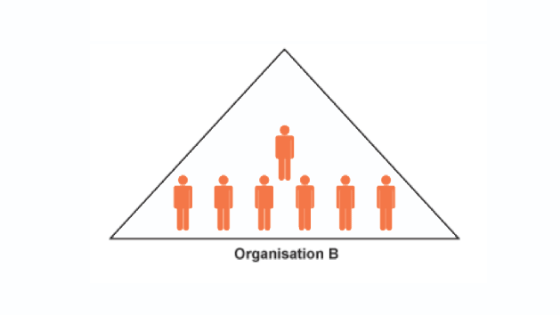Organisational structures
Passing your examination!
In the written examination for this Unit, you will need to be able to demonstrate your knowledge and understanding of the following assessment criteria:
1.3.2 Organisational structures
You will know and understand the features of organisational structures, linked to span of control and chain of command. You will know and understand the advantages and disadvantages of organisational structures, including:
- Flat organisational structures
- Tall organisational structures
1.3.3 Restructuring
You will know and understand how and why a business may restructure its organisation, including:
- Delayering
- Redundancies
You’ll find lots of useful information on the following pages to help you complete this part of your examination.
The way in which a business is organised (structured) is important as it can have a direct impact on the way that people communicate and work with each other. The organisational structure will show:
- Who reports to whom, and who is responsible for each area and function
- Individual roles and job titles
- Who is accountable to whom
- The way in which communication flows through the business
The way in which authority/responsibility flows down through the organisation and accountability flows upward is referred to as the chain of command.
Depending on the number of layers in an organisation’s structure, it may be classed as being either tall (lots of layers) or flat (very few layers). Take a look at the following examples – Organisation A has a tall structure, while Organisation B has a flat structure. As you can see, organisations that have a flat structure will have very few layers of management, which gives employees more control and responsibility for making decisions. Communication is easier within a flat structure as staff have easy access to each other.
Click on each organisational structure diagram to find out more.
Tall organisational structures
In an organisation with a tall structure, there are many levels (or layers) of hierarchy. There is a very clear structure within the organisation and lines of communication and responsibilities of workers are well defined.
The span of control (which is the number of employees reporting directly to a line manager) is narrow in these organisations – this means that individuals aren’t responsible for too many colleagues.
There are lots of opportunities for promotion in tall organisations – this can help to motivate staff as they are able to grow and develop within the organisation.
Lines of communication are long in these organisations – this means that information takes a long time to flow through the organisation, which means that the business takes longer to make decisions and it is generally unresponsive to change.
Flat organisational structures
In an organisation with a flat structure, there are fewer levels (or layers) of hierarchy. This structure is common in new and smaller businesses – fewer managers are needed, which can significantly reduce business costs.
The span of control is wide in these organisations – this means that tasks must be delegated (this is when authority/responsibility is given to a member of staff, allowing them to make decisions on behalf of their manager). This can help to make employees feel trusted, valued and motivated.
Lines of communication are short in these organisations, as there are not as many layers as in tall organisations – this means that communication is quicker, mistakes in communication are reduced and the business is generally more responsive to change.
Potential disadvantages in this type of structure are that managers are often responsible for a lot of people, which can make it more difficult to keep track of what everyone is doing. In addition, there can be less opportunity for promotion in flat organisations, which can leave some employees feeling demotivated.


